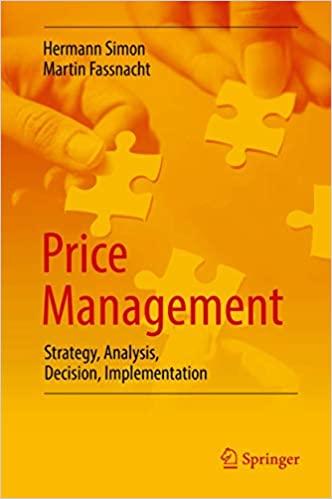Question
Question 21 Consultant X is busy with an evaluation research study and is conducting an efficiency analysis for a local banking group. Consultant X is
Question 21
Consultant X is busy with an evaluation research study and is conducting an efficiency analysis for a local banking group. Consultant X is busy with a cost-benefit analysis stage. At what time of the programme analysis will a cost-benefit be applied or used?
a.
Planning phase
b.
Beginning phase
c.
Middle phase
d.
End phase
Question 22
Which methods and processes of analyses considers available resources, such as the time available to complete the study and any available funding resources.
a.
Time to conduct the study
b.
Intent
c.
The complexity of the design
d.
The expertise of the researcher
Question 23
Because qualitative data analysis involves continuous analysis and interpretation, it is particularly important to constantly be aware of your ______ framework, research questions, methods, values, and biases, and of your presence in the very situations you study.
a.
methodological
b.
conceptual
c.
philosophical
d.
theoretical
Question 24
Lecturer K is teaching Psychology. S/he is also engaged in research activities and is also a talented photographer. Lecturer K uses her/his own photos in their research practices. Lecturer K indicated that using their art in research enabled them to experience a more direct and first-hand approach and enabled them to get closer to the artistic process than they could by interviewing others. If lecturer K were involved in film production, which art-based research would they have been involved with?
a.
Visual arts
b.
Performing arts
c.
Audio-visual art
d.
Theatre
Question 25
Community stakeholders must be assisted in developing skills to become the masters of their development, while you as the researcher must be informed and educated about cultural norms, practices, and behaviours that are essential to fostering relationships with community stakeholders. This relates to ____.
a.
Capacity building
b.
Co-construction of knowledge
c.
Research with, not on
d.
Democratic environments
Question 26
To which orientation of autoethnography is personal experiences used to describe and understand cultural expectations and experiences.
a.
Social science / analytical
b.
Creative / artistic
c.
Humanistic / interpretative
d.
Critical
Question 27
The main research strategies employed for qualitative inquiry entail:
Number:
(i) Case studies
(ii) Explanatory design
(iii) Ethnography
(iv) Grounded theory
(v) Exploratory design
(vi) Participatory action research
a.
Number (ii), (iii), (iv) and (v)
b.
Number (i), (iii), (iv) and (vi)
c.
Number (iii), (iv), (v) and (iv)
d.
Number (i), (ii), (iii) and (iv)
Question 28
Which category links to observing and describing cultural behaviour over a prolonged period?
a.
Case study
b.
Phenomenology
c.
Ethnography
d.
Grounded theory
Question 29
Which methods and processes of analyses uses a series of steps that you should follow to create meaning out of a relatively large amount of data that have been collected. As an outcome, a conclusion can be made based on obtained data. The cycle of analysis may be seen as moving from results through inductive logic to generalisations or theory, and from general inferences (or theory) through deductive logic to tentative hypotheses or predictions of events or outcomes.
a.
Divergence of results
b.
Explanatory sequential design
c.
Inference
d.
Convergent design
Question 30
What is a key factor to consider when performing univariate analysis on nominal variables?
a.
The range of values
b.
The median of the data
c.
The measurement of dispersion
d.
The mode of the distribution
Step by Step Solution
There are 3 Steps involved in it
Step: 1

Get Instant Access to Expert-Tailored Solutions
See step-by-step solutions with expert insights and AI powered tools for academic success
Step: 2

Step: 3

Ace Your Homework with AI
Get the answers you need in no time with our AI-driven, step-by-step assistance
Get Started


